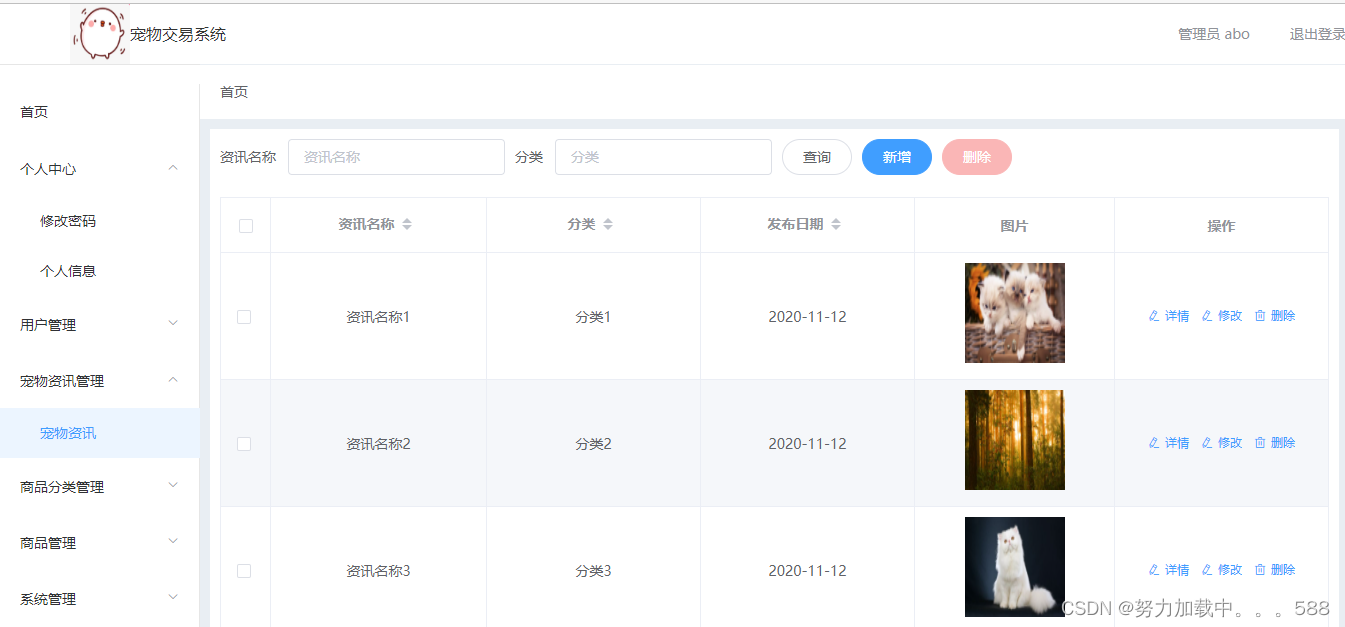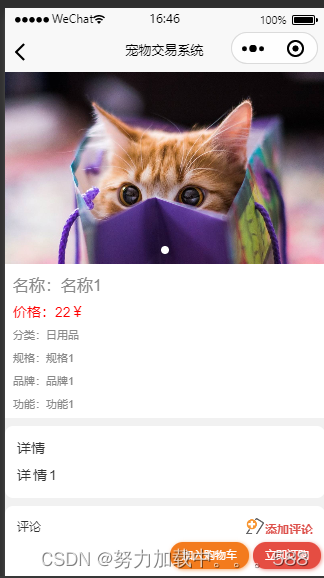摘要
本文设计并实现了一款基于SSM框架的宠物交易管理系统小程序。宠物交易作为一个不断增长的行业,需要一个高效、安全、易用的管理系统,以满足用户对宠物购买、交易和信息管理的需求。为此,我们选择使用SSM框架,该框架整合了Spring、SpringMVC和MyBatis,提供了一套全面的解决方案。
在系统需求分析阶段,我们明确定义了系统的功能需求,包括宠物信息管理、用户注册与登录、宠物交易和订单管理等。同时,我们划分了用户角色,以确保系统的安全性和合理性。在技术选型方面,我们对比了多种技术方案,最终选择了SSM框架,基于其成熟性、稳定性和灵活性。
系统设计中,我们详细阐述了系统的架构设计,包括前端和后端的模块划分。数据库设计方面,我们设计了清晰的表结构和关联关系,以支持系统的数据操作需求。在系统实现中,我们展示了关键代码片段,包括控制器、服务和持久层的代码,同时介绍了前端使用的技术。
最后,通过用户手册和部署说明,我们提供了系统的使用方法和部署步骤。总结中,我们总结了系统设计与实现的经验,并对未来可能的改进和扩展方向进行了展望。
关键词:宠物交易,SSM框架,系统设计,实现,安全性设计,性能评估。
-
引言
- 背景介绍
- 问题陈述
- 目标和意义
-
系统需求分析
- 功能需求
- 用户角色划分
- 性能和安全性需求
-
相关技术介绍
- SSM框架概述
- 各个组件的作用
- 框架选择的原因和优势
-
系统设计
- 架构设计
- 前端模块划分
- 后端模块划分
- 数据库设计
- 表结构设计
- 关联关系
- 数据流程和交互流程
- 架构设计
数据库设计代码:
// 宠物信息表
CREATE TABLE pet_info (
pet_id INTAUTO_INCREMENT,
pet_name VARCHAR(50) NOT NULL,
pet_type VARCHAR(50) NOT NULL,
pet_breed VARCHAR(50) NOT NULL,
pet_age INT,
pet_price DECIMAL(10, 2) NOT NULL,
pet_description TEXT,
pet_image_url VARCHAR(255),
FOREIGN KEY (seller_id) REFERENCES user_info(user_id)
);
// 用户信息表
CREATE TABLE user_info (
user_id INT PRIMARY KEY AUTO_INCREMENT,
username VARCHAR(50) NOT NULL,
password VARCHAR(255) NOT NULL,
email VARCHAR(100) NOT NULL,
address VARCHAR(255)
);
// 订单信息表
CREATE TABLE order_info (
order_id INT PRIMARY KEY AUTO_INCREMENT,
user_id INT,
pet_id INT,
order_date TIMESTAMP DEFAULT CURRENT_TIMESTAMP,
FOREIGN KEY (user_id) REFERENCES user_info(user_id),
FOREIGN KEY (pet_id) REFERENCES pet_info(pet_id)
);
// 交易日志表
CREATE TABLE transaction_log (
log_id INT PRIMARY KEY AUTO_INCREMENT,
order_id INT,
transaction_amount DECIMAL(10, 2) NOT NULL,
payment_method VARCHAR(50) NOT NULL,
FOREIGN KEY (order_id) REFERENCES order_info(order_id)
);
-
技术选型与理由
- 对比其他可能的技术选型
- SSM框架的优势和适用场景
-
系统实现
- 具体实现步骤
- 关键代码片段展示
- Controller
- Service
- DAO
后端代码实现:
Controller层
import org.springframework.beans.factory.annotation.Autowired;
import org.springframework.web.bind.annotation.*;
@RestController
@RequestMapping("/pet")
public class PetController {
@Autowired
private PetService petService;
@GetMapping("/{petId}")
public Pet getPetById(@PathVariable int petId) {
return petService.getPetById(petId);
}
@PostMapping("/add")
public void addPet(@RequestBody Pet pet) {
petService.addPet(pet);
}
// 其他宠物管理的接口,如更新宠物信息、删除宠物等
}
Service层
import org.springframework.beans.factory.annotation.Autowired;
import org.springframework.stereotype.Service;
@Service
public class PetService {
@Autowired
private PetDao petDao;
public Pet getPetById(int petId) {
return petDao.getPetById(petId);
}
public void addPet(Pet pet) {
petDao.addPet(pet);
}
// 其他宠物管理的业务逻辑,如更新宠物信息、删除宠物等
}
DAO层
import org.apache.ibatis.annotations.Mapper;
import org.apache.ibatis.annotations.Param;
@Mapper
public interface PetDao {
Pet getPetById(@Param("petId") int petId);
void addPet(Pet pet);
// 其他宠物管理的数据库操作,如更新宠物信息、删除宠物等
}
前端实现页面代码:
<template>
<div>
<h2>宠物列表</h2>
<ul>
<li v-for="pet in pets" :key="pet.petId">
{
{ pet.petName }} - {
{ pet.petType }} - {
{ pet.petBreed }}
</li>
</ul>
</div>
</template>
<script>
export default {
data() {
return {
pets: []
};
},
mounted() {
// 从后端获取宠物列表数据
this.fetchPetList();
},
methods: {
fetchPetList() {
// 调用后端接口获取宠物列表数据
// 可以使用axios或其他HTTP库进行请求
// 示例:axios.get('/pet/list').then(response => { this.pets = response.data; });
}
}
};
</script>
<template>
<div>
<h2>宠物详情</h2>
<div>
<strong>{
{ pet.petName }}</strong> - {
{ pet.petType }} - {
{ pet.petBreed }}
<p>{
{ pet.petDescription }}</p>
</div>
</div>
</template>
<script>
export default {
data() {
return {
pet: {}
};
},
mounted() {
// 从后端获取宠物详情数据
this.fetchPetDetails();
},
methods: {
fetchPetDetails() {
// 调用后端接口获取宠物详情数据
// 示例:axios.get(`/pet/${this.$route.params.petId}`).then(response => { this.pet = response.data; });
}
}
};
</script>
-
系统测试与性能评估
- 性能分析测试方法
-
用户界面设计
- 页面布局
- 交互设计
- 选择的设计风格和元素
程序实现部分页面:




-
安全性设计
- 用户身份验证
- 数据加密
- 防范网络攻击
-
用户手册和部署
- 使用方法
- 部署过程
-
总结与展望
- 设计和实现的经验总结
- 对未来改进和扩展的展望
-
参考文献
更多精彩内容,关注继续观看!!- 引用所参考的文献和资料